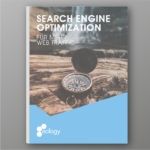
There are now countless KPIs that help you measure success - in the SEO area, too, of course. But which of them are really fundamental and relevant? You can find out here. ... Continue reading
| 15 min |


| 17 min |
How can I make my website rank higher in Google search results? Surely you have asked yourself this question before. With a well-developed SEO strategy, however, this is not so difficult and effective in the long term. We would like to show you how you can conceptualize your own SEO strategy in just 8 steps, which is suitable for your company and your individual goals.
What is an SEO strategy?
Why does successful search engine optimization require an SEO strategy?
Develop your own SEO strategy in 8 steps
Why is a good SEO strategie crucial for success?
When will the first results be visible and the successnes measurable?
Our summary
An SEO strategy gives you an overview of what you want to achieve with your search engine optimization (SEO for short). It contains the details of how you want to achieve the goal and breaks down the methods that you will use. With an SEO strategy you create an individual roadmap for your SEO measures. With the help of this strategy, you determine your prioritized goals and only then go into the implementation of the measures to achieve them.
Depending on your business model and your specific goals, these measures can vary:
The development of a targeted SEO strategy usually means an increased investment of time. You may ask yourself whether all this work is really necessary. Is it not enough to carry out a few basic SEO measures on the side?
Our answer is definitely: No, that is not enough! We would like to give you three arguments why it makes sense to develop an SEO strategy:
With the following steps you can create the basis for your own SEO strategy. It is important for you to note that this guide is not set in stone, it is more about the systematic approach, so that you can set up a strategy 😊
Some points are probably already familiar to you or you have already executed them – here you can then still optimize something to really get the best out of it.
Ask yourself first and foremost: What do I want to achieve with my website? “Everyone else is doing it and getting more visitors” – with this mindset you are not in a good starting position. You need a clear idea of what you want to achieve with SEO and whether this goal is realistic. Just because others do it that way, doesn’t necessarily mean that it makes sense for you as well. Think about how you can support your current business model through SEO so that something moves and brings you long-term success. Define your goals as clearly as possible:
| Vaguely determined target | Precisely determined target |
| I want a higher conversion rate. | I want to increase my conversion rate by 5% in the next 9 months. For this, I will revise my product pages so that my products are displayed in the TOP results in the SERPs after 6 months at the latest. |
Key Performance Indicators, or KPIs for short, are the most important key figures that help your company define the appropriate business goals. As soon as you have defined your overall goals from step 1, they become measurable for you. To do this, you should define the most important performance indicators for you. These metrics will help you determine if you are making progress toward your goals. For example, if one of your goals is to increase the conversion rate on your website, you should track the visits to your website, the bounce rate, the average time spent on your website, and of course the conversion rate.
The competitor analysis gives you information about how your company compares to your competitors. This way you can determine whether you are performing better or worse than your competitors and whether your strengths and weaknesses match those of your competitors. For example, if you don‘t rank well for certain keywords, the competitor analysis can show you why that is.
Now it’s time to take an in-depth look at your existing website and see if every aspect is optimized for maximum performance. Start with an SEO audit, where you check the technical details of your website:
These are the first points that you should take a closer look at and can already optimize if necessary. Next, you should focus on the content of your website. Make sure that the individual pieces of information are relevant and interesting for the user. This way you can increase the dwell time your website. Finally, you can also take a closer look at the off-page optimization of your website:
Based on all these questions, you can check whether you are already actively working on a good position in the SERPs and can still refine your tactics.

We will gladly explain to you how to succeed in a perfect SEO audit 😊
Keywords are important for SEO, no question. However, you should also know the search intention of your target group. Only if you know your target group and adjust your keyword research to their needs, you can be found better. You need to understand who your customers are and what their interests are. For this you can create a persona in advance. These are fictional characters that represent groups of people similar to your actual customer base. They serve to describe your ideal customer and help you find out what kind of search intentions and keywords users use when searching Google.

Learn more about how to create a detailed keyword research here.
First, you should note that your content strategy depends on your pre-defined goals of your overall SEO strategy. To come back to our example from point 1: If you want to increase your conversion rate, your focus will not be on non-commercial content. However, you should still provide the user with informative content about your company and service to build trust.
In your content strategy you determine which content, for which search terms from your keyword research, should be developed or optimized by which date. It is best to record your ideas and goals in a content plan. Based on this plan, you can now create content for your website and always have an overview of when you want to optimize for certain keywords or search intentions.
Now it’s time to set your priorities right. The information you have gathered in the previous steps will be of no use to you if you do not generate the right actions from it. Now you go through step by step which actions are most important to you based on your defined goals.

When prioritizing your topics, always keep the effort in mind. Small improvements with little effort can be implemented by you at the same time as larger SEO optimizations.
You have developed your working SEO strategy, have already taken the first measures to implement it or have already implemented all of them… That’s great – congratulations! 🙂
However, this is no reason to put your feet up now. Regularly check the actual status of your defined SEO goals and whether your work really produces the result you want. Since the Google algorithms are also constantly evolving, it is advisable to check your SEO strategy every 6-12 months again on heart and kidney. In this period, the goal of your SEO strategy can also change. So always stay on the ball and check regularly if your SEO strategy is still up to date.
By creating an SEO strategy, you get an overview of where you currently stand in search engine optimization and where you would like to go. With the intensive examination of your business goals and your target group, you know them exactly and can act accordingly. For long-term growth, it is important to be open to new ideas and adapt quickly to changing circumstances. A measure is good until the underlying circumstances change. And that’s why you need an SEO strategy that you update regularly and align with your goals.
Of course, you want to harvest the fruits of your labor as soon as possible. Unfortunately, we can’t give you an exact time when you can see the first results. The Googlebot crawls the web regularly for new content and changes. However, the frequency at which this happens is one of Google’s trade secrets 😉Our experience shows that it takes about 3-6 months until you can see the first results in the SERPs. Tools like the Google Search Console can help you to evaluate your success.
Take your time to work out your SEO strategy and make sure to pursue your goals consistently. Aimless optimization without a fixed roadmap will not bring you forward and can even harm you in the worst case. Especially in the field of search engine optimization, it is important to constantly pursue and optimize the strategy. This is the only way to stay in the TOP search results of Google in the long run. So inform yourself regularly about innovations and always keep an eye on your business goals to be able to optimally exploit your measures from your SEO strategy at any time.

You want to learn more about how to optimize for search engines?